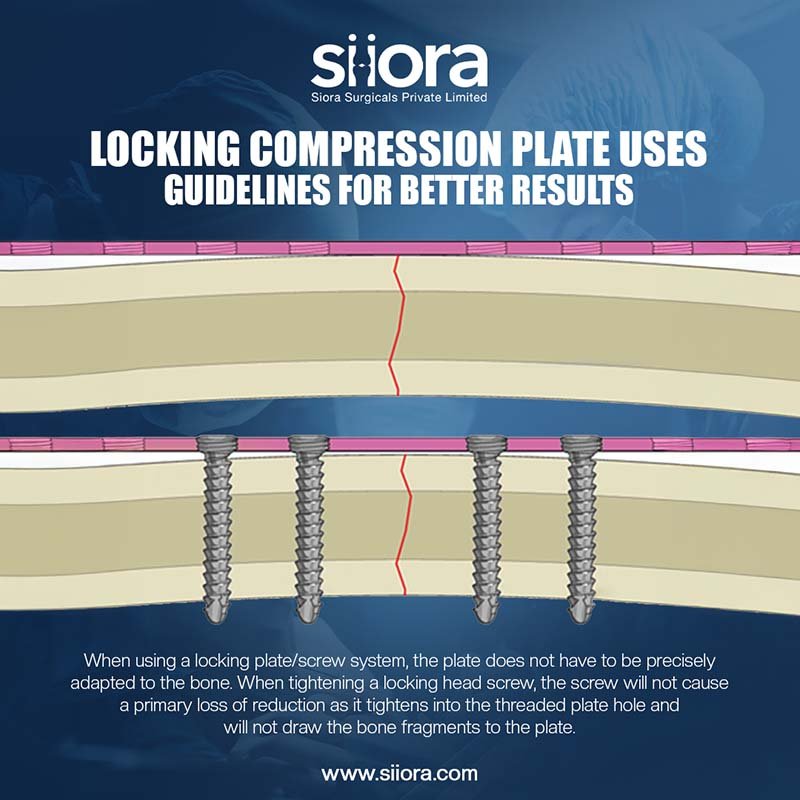Pins are versatile and are usually helpful for internal fixation. A pin has a comparatively small diameter and is inserted through the soft tissue and bone with comparatively little trauma. A Kirschner wire is inserted with a power drill as well as a guidance system. The soft tissues tend to wind round the Kirschner wire at the time of insertion and must always be protected. Several types of guides are in use: a telescoping guide linked to the drill, or an external guide with a handle are common orthopedic Instruments. A power drill with a quick locking and release mechanism save considerable time. It is also suitable for insertion of Kirschner wire from the barrel of the drill, that doubles as a guide.
What Are the Uses of K-wires?
K-wires, or Kirschner wires, are thin, stainless steel pins used in orthopedic surgery. They stabilize bone fragments in fractures, especially in small bones like those of the hand, wrist, and foot. Surgeons often use K-wires for temporary fixation during complex bone repairs or to hold implants in place. They’re also useful in pediatric fractures due to their minimal invasiveness. K-wires can be inserted percutaneously, reducing the need for large incisions. In joint surgeries, they help maintain alignment while healing occurs. Although not always used for permanent fixation, K-wires offer reliable support during the early stages of recovery. Once healing progresses, they’re usually removed in a simple outpatient procedure. Their versatility and ease of use make them a staple in orthopedic care.
How to Insert a Kirschner Wire?
Here are the steps for Kirschner wire insertion:
- Always deploy a power drill to insert a Kirschner wire.
The wire bends once it’s inserted on a hand drill.
- To protect soft tissues during insertion, always use a guide to direct the pin.
- Cutting
- Support the wire.
- Place the cutter jaws at right angles to the wire.
- Bend the wire up after cutting.
- Tip of wire must not touch the plaster cast.
Fashion a point- 2 oblique cuts to fabricate a sharp tip
Different Types of Fixations Using K-wire
K-wires can be applied for provisional or definitive fixations. Here’s a detailed look:
Provisional fixation
Kirschner wires are helpful for provisional fixation of a comminuted fracture. They help in accurate placement of the fragments and orthopedic implants, especially the plates and the bone screws. Multiple wires are inserted without any added trauma. When provisional stability has been attained, X-ray pictures can be made to visualize the strength as well as weakness of the construct.
Planning is necessary while inserting Kirschner wires for provisional fixation. Pins are introduced in such a way that they don’t obstruct the final placement of the definitive implants. For instance, wires are passed parallel to each other in the same direction in which the lag screw is to be introduced in order that there’s no obstruction to compression of the fracture with the lag screw.
Definitive fixation
Whenever a Kirschner wire is used for definitive fixation, the pin’s end should be cut a centimeter under the skin and may be bent; a long wire end will protrude through the skin, either because of the pressure from within or from outside. If a wire is cut too near the bone, it’s difficult to locate it at the time of removal. The jaws of a wire cutter are always positioned at right angles to the wire. If they’re positioned at any other angle, a twisting force develops whereas snapping the wire. This force is transferred to the bone and due to this unintentional fracture may occur in a small bone, specifically in the cancellous area.
A sharp point at the pin trip may be fabricated by making an oblique cut and then rotating the pin to make the 2nd oblique cut. The free end of the wire must always be bent with an orthopedic instrument. The bending force, if transmitted to the bone, may cause an inadvertent fracture; this complication is avoided by gripping and stabilizing the pin at the time of bending. There’s a genuine danger of migration of a straight pin into the soft tissues or into the bone; a pin is known to travel a long distance across the planes of soft tissue. When using a pin around the shoulder, it’s imperative that the trip be bent.
A pin enclosed in a plaster cast shouldn’t touch the cast but move freely inside. There’s considerable movement between the cast and the bone because of the presence and the thickness of the soft tissues. If any pin touches the plaster, forces are transferred to the bone, resulting in pin loosening as well as loss of fixation. A pin must be removed after it has served its purpose.
How to Care for K-wires After Insertion at Home?
Here are the tips you need to follow:
- Maintain proper cleanliness around the pin area.
- Use a clean cloth or cotton swab with saline solution to gently clean the skin near the wire.
- Do not twist, pull, or move the wire to avoid injury or displacement.
- Cover the pin site with a fresh, sterile dressing as directed by your doctor.
- Watch closely for any signs of infection like redness, swelling, warmth, or unusual pain.
- Avoid soaking the wire in water; protect it with a waterproof cover when showering.
- Limit physical activity that may strain or bump the wire.
- Contact your healthcare provider right away if the wire feels loose or if you notice discharge.
- Attend all scheduled medical check-ups for proper healing progress.
When to See a Healthcare Provider for K-Wire Removal?
Pay attention to these for K-wire removal:
Scheduled Removal
Visit your healthcare provider on the date they recommend for K-wire removal, usually 3 to 6 weeks after insertion.
Signs of Infection
Seek immediate medical attention if you notice redness, swelling, warmth, pus, or increasing pain around the K-wire site.
Wire Loosening or Movement
If the K-wire feels loose, moves, or protrudes unexpectedly, consult your provider promptly.
Severe Pain or Discomfort
Persistent or worsening pain that doesn’t improve with medication warrants evaluation.
Skin Irritation or Breakdown
Any skin damage or ulceration near the wire site needs medical review.
Difficulty Using the Affected Limb
Reduced movement or function signals a need for professional assessment.
Fever or Systemic Symptoms
Fever or chills along with local symptoms require urgent care.
How is a K-wire Removed?
Here are the general steps followed during K-wire removal:
- Patient Preparation: Inform the patient about the process and ensure they are relaxed and well-positioned.
- Clean the Area: Thoroughly disinfect the skin around the wire’s entry point to prevent infection.
- Pain Management: Apply local anesthesia if necessary to reduce discomfort during removal.
- Access the Wire: Carefully uncover the exposed end of the K-wire by removing any coverings.
- Secure the Wire: Use sterile pliers or forceps to firmly grip the wire.
- Extract the Wire: Pull the K-wire out gently and steadily, avoiding sudden movements to prevent tissue injury.
- Post-Removal Care: Dress the wound with a sterile bandage to protect it.
- Observe: Keep an eye on the site for bleeding, swelling, or infection after removal.







